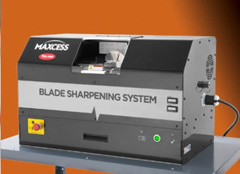AIMCAL: Tidland Gives Blades a ‘Sharper Image’
- Published: March 11, 2012
FORT Mill, SC | The Assn. of Intl. Metallizers, Coaters & Laminators (AIMCAL) bestows is Technology of the Year Award to Maxcess’s Tidland Corp., Camas, WA, for its Blade Sharpening System. The system resharpens shear slitting blades without requiring removal from the knifeholder cartridge.
 In use, the operator reportedly simply places the knifeholder cartridge with the dull blade in the Blade Sharpener, closes the lid, and pushes the start button. In less than 90 sec, the blade is sharpened, and the knifeholder cartridge can be removed from the machine and replaced on the knifeholder control body.
In use, the operator reportedly simply places the knifeholder cartridge with the dull blade in the Blade Sharpener, closes the lid, and pushes the start button. In less than 90 sec, the blade is sharpened, and the knifeholder cartridge can be removed from the machine and replaced on the knifeholder control body.
The patented design, introduced in April 2011 at ICE USA in Orlando, FL, is said to eliminate the need, expense, and turnaround time involved with sending blades out to be reground. In addition to enabling in-house sharpening, the unit is claimed to reduce blade inventory dramatically and improve operator safety since the operator never touches the blade.
Sharpening the blade directly on the knifeholder cartridge also reportedly reduces blade runout. The system, measuring approximately 3 x 3 x 2 ft, is compatible with Tidland Performance Series, Series C Swing and e-Knifeholder Class II and Class III blade cartridges. The standard grind angle is 25 deg; however, the grind angle can be set as small as 5 deg or as large as 50 deg.
Optical Density/Coating Defect Detection
The Registron Hawkeye Inspection System from Bobst Group's General Vacuum Equipment Ltd., Heywood, UK, received finalist status in the Metallizing Equipment/Accessories Category.
The patent-pending unit measures optical density and detects coating defects on any transparent substrate. Mounted within the vacuum metallizer, the inspection system measures optical densities from 0 to 4.5 with an accuracy of 0.1 at 1,000 mpm. Multi-probe transmission sensors positioned at 25-mm intervals measure attenuation of transmitted signals to measure optical density and identify any nonmetallized areas. The machine also detects pinholes and scratches across the entire metallized width of the web.
Holes as small as 0.10 mm are counted and classified in four size categories. Closed-loop control allows metallization to be adjusted on the fly. In-process description of metallizer defects are expected to improve quality and output through better understanding of defect causes and trends. In time, as performance data accumulates, engineers at General Vacuum predict the equipment will be able to identify other types of defects.
Process for Seamless Roller Coverings
Earning finalist status in the Coating/Laminating Equipment/Accessories Category is Menges Roller Co., Inc., Wauconda, IL, for its Process for Seamless Roller Coverings. Instead of traditional rubber extrusion, Menges relies on a proprietary compounding and application process that crosslinks the rubber after it's applied.
The technology eliminates problems with rubber memory that can cause variations too small to see with the naked eye but sufficient to cause inconsistencies in roller performance. Designed for any application that uses rollers, the Process for Seamless Roller Coverings technology offers the potential to improve the output of coating, laminating, film manufacturing, and metallizing lines.
The elimination of roller imperfections minimizes film finish irregularity problems like gloss and haze and reduces rejected material and waste. Fewer roller flaws are said to mean fewer roll changes and associated downtime as well as lower roller and plant maintenance costs.
Noting that roller surface has a direct bearing on product quality, the judges believed the Menges Process for Seamless Roller Coverings will prevent many roll defects. It also has broad application since virtually any web-handling machine could benefit.
Solid State Laser Inspection Technology
Receiving an honorable mention in the Coating/Laminating Equipment/Accessories Category for its patent-pending NxtGen SSLR Solid State Laser Inspection Technology is Dark Field Technologies, Orange, CT. The clear or tinted media includes display glass, coated film, solar film, coated glass, solar glass, metals LCD glass, and silicon wafers.
The unit delivers high-speed (1,000 mpm), high-resolution inspection, metrology, and defect detection in sheets and roll-to-roll products. It also monitors haze measurement online in real time. Using a combination of solid-state lasers and high-speed line-scan cameras, the system generates defect images with 20 times more imaging pixels than conventional technologies to identify problems like coating flaws, gel and distortion lines, craters, gel strings, orange peel, and the tiny bubbles. The self-aligning system is claimed not affected by mechanical drift or vibration. With no light bulbs or moving parts, the Dark Field system reportedly requires no maintenance.
The judging panel agreed the NxtGen SSLR technology opens the door to more detailed defect detection and lower inspection costs.
Holding the Gavel
Judges for the Technology of the Year Competition included Dr. Edward D. Cohen, AIMCAL consultant--Coating and Laminating; Dr. Eldridge M. Mount, AIMCAL consultant--Metallizing; Dr. Charles A. Bishop of C.A. Bishop Consulting, Loughborough, UK; Larry Gogolin of Gogolin Assoc., Bolton, MA; and Dr. Don McClure, president of Acuity Consulting and Training, Siren, WI. AIMCAL Awards Committee chair Randy Apperson, director of sales & marketing at Finzer Roller, Des Plaines, IL, moderated the judging teleconference.





